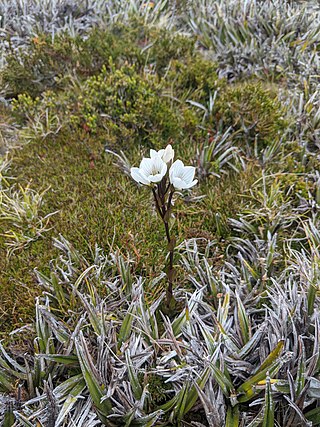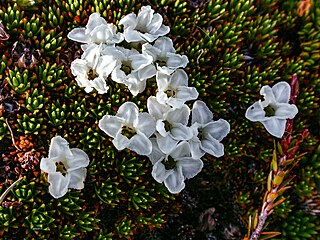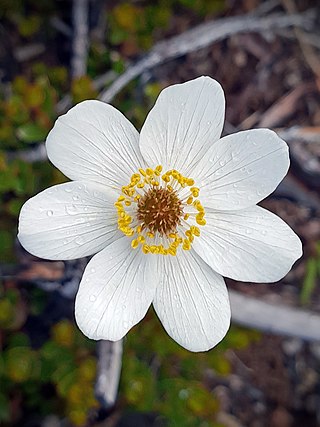
Diselma archeri is a species of plant of the family Cupressaceae and the sole species in the genus Diselma. It is endemic to the alpine regions of Tasmania's southwest and Central Highlands, on the western coast ranges and Lake St. Clair. It is a monotypic genus restricted to high altitude rainforest and moist alpine heathland. Its distribution mirrors very closely that of other endemic Tasmanian conifers Microcachrys tetragona and Pherosphaera hookeriana.

Atriplex cinerea, commonly known as grey saltbush, coast saltbush, barilla or truganini, is a plant species in the family Amaranthaceae. It occurs in sheltered coastal areas and around salt lakes in the Australian states of Western Australia, South Australia, Tasmania, Victoria and New South Wales. The species is also known to be present in the Waimea inlet in New Zealand, although has historically been found in Boulder Bank, D'Urville Island, and Palliser Bay.

Bellendena montana, commonly known as mountain rocket, is a species of low-growing multi-stemmed shrub in the plant family Proteaceae. It is endemic to high-altitude subalpine and alpine regions in Tasmania, Australia. The prominent white flower spikes appear over summer, followed by small bright red or yellow fruit in late summer and autumn.

Goodenia montana, commonly known as mountain velleia, is a flowering plant in the family Goodeniaceae. It is a small, perennial herb with lance-shaped to egg-shaped leaves with the narrower end towards the base, and yellow flowers. It mainly grows in woodland and sub-alpine grasslands in New South Wales, Victoria and Tasmania.

Ewartia planchonii, commonly known as creeping cushionherb, is an endemic herb to alpine areas of Tasmania. E. planchonii is commonly found in the western highlands of Tasmania. The Ewartia genus is described as cushion plants/herbs due to the characteristic growth habits of low growing, highly compact mats which are made up of highly packed stems. These mats are slow-growing and are often located in soils that contain low nutrients.

Richea pandanifolia, the pandani or giant grass tree, is a distinctive endemic Tasmanian angiosperm. It is dicot of the family Ericaceae and is found in central, western and south west Tasmania. It is a favourite among hikers and nature lovers.

Archeria is a small genus of shrubs in the family Ericaceae. As currently circumscribed the group includes six species, all native to southern Australasia. Four of these are endemic to Tasmania, and the other two endemic to New Zealand.

Pterygopappus is a genus of flowering plants in the tribe Gnaphalieae within the family Asteraceae. There is only one known species, Pterygopappus lawrencii, which is endemic to alpine Tasmania. It forms thick, light blue/green mats with densely packed leaves. It is most common in the mountains of the northeastern part of the island. It is a slow grower and prefers cool, moist environments.

Dracophyllum milliganii is a species of angiosperm in the family Ericaceae and the sub-family Epacridoideae. It is a distinctive alpine shrub, endemic to western Tasmania.

Pittosporum bicolor, commonly known as cheesewood or banyalla, is a flowering shrub or small tree of the family Pittosporaceae, and is native to south eastern Australia.

Agastachys odorata, commonly known as the white waratah or fragrant candlebush, is the sole member of the genus Agastachys in the protea family. It is an evergreen shrub to small tree and is endemic to the heaths and buttongrass sedgelands of western Tasmania.

Carex archeri, known as Archer's sedge, is a species of sedge in the genus Carex, endemic to south-eastern Australia.

Gonocarpus montanus is a perennial, terrestrial herb in the family Haloragacae. It is native to N.S.W, Victoria, Tasmania and New Zealand. Common names include mountain raspwort and mat raspwort. Its synonym is Haloragis montana.

Gonocarpus micranthus commonly called creeping raspwort is a prostrate, ascending or erect perennial herb in the family Haloragaceae. It is native to Australia, New Zealand, New Guinea, South-east Asia, Japan and the Himalaya.

Chionogentias diemensis is a flowering herbaceous alpine plant in the family Gentianaceae, endemic to the island of Tasmania in Australia. It is commonly known as the Tasmanian mountain gentian. Chionogentias diemensis has been classified into two sub-species: the Tasmanian snow-gentian and the Ben Lomond snow-gentian.

Dracophyllum minimum, commonly known as heath cushionplant or claspleaf heath, is a species of bolster cushion plant endemic to Tasmania, Australia. It is a low growing, highly compacted plant with white flowers, commonly found in alpine areas of the south, centre and west of Tasmania.

Ewartia meredithiae, commonly known as the rusty cushion plant, is a Tasmanian endemic cushion plant species. Out of the four species in Australia from this small genus, Tasmania has three, all of which are low growing, alpine species.

Anemone crassifolia, commonly known as mountain anemone, is a perennial herb in the family Ranunculaceae and is endemic to Tasmania, Australia. The species is common in high alpine moorlands of western and southern Tasmania at approximately 1000m. It is the only representative of the genus Anemone found in Australia.
Sprengelia montana is a species of flowering plant of the family Ericaceae, and is endemic to Tasmania. It is a small, erect shrub with overlapping, stem-clasping, egg-shaped leaves, and pink flowers, sometimes in groups of up to 10 on the ends of branches.

Schizacme is a genus of flowering plants in the family Loganiaceae. It includes five species native to southeastern Australia (Victoria), Tasmania, and the South Island of New Zealand.


















